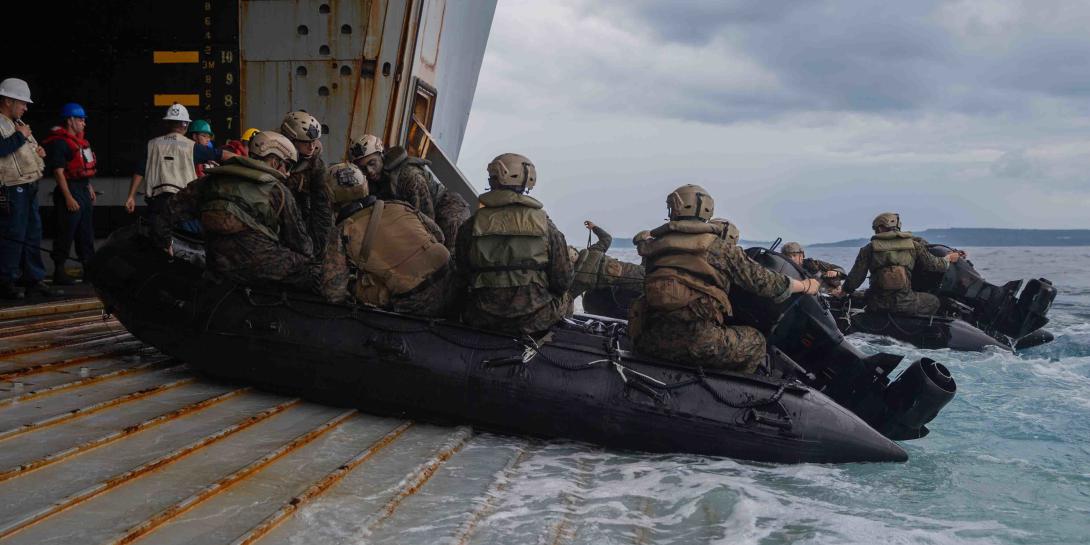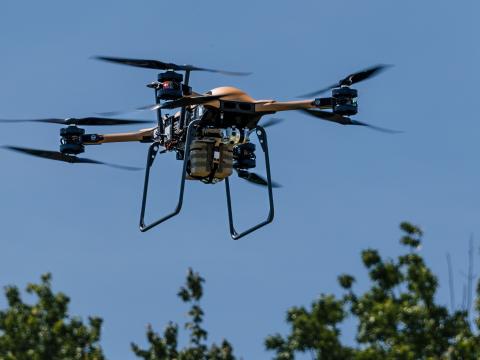Marines Assume Navy Role in New Integration
The U.S. Marine Corps is shifting its emphasis to become more of a force integrated with that of the U.S. Navy, leaders of both services said. The two services will focus more on coordinated rather than complementary operations that will be supported by advanced communications and networking technologies.
These were among the points discussed in the opening panel session at West 2021, the two-day virtual conference cosponsored by AFCEA International and USNI. Being held June 29-30, the event’s focus is on the promise and progress of naval integration.
Industry should communicate with us. Tell us where you are fiscally constrained and where our requirements are too optimistic.—Lt. Gen. Eric M. Smith, USMC, deputy commandant for combat development and integration and commanding general of the MCCDC @USMC #WEST2021
— Bob Ackerman (@rkackerman) June 29, 2021
Vice Adm. James Kilby, USN, deputy chief of naval operations for warfighting requirements and capabilities, N9, Office of the Chief of Naval Operations, pointed out that the Navy largely has focused on power projection, but that approach has changed. “Now, we’re trying to rebalance our forces to focus on sea control and power projection,” he elaborated.
Recently, we focused on power projection. Now, we’re trying to rebalance our forces to focus on sea control and power projection.—Vice Adm. James Kilby, USN, deputy chief of naval operations for warfighting requirements and capabilities, N9, @USNavyCNO #WEST 2021
— Bob Ackerman (@rkackerman) June 29, 2021
And the Marine Corps is part of that new strategy. It is being integrated into Navy operations to a greater degree, which is changing the way it is employed. “What we do is enable fleet maneuver. That is what we’ve always done,” said Lt. Gen. Eric M. Smith, USMC, deputy commandant for combat development and integration and commanding general of the Marine Corps Combat Development Command. Now, “We enable distributed maritime operations. We enable sea denial,” he added.
We [USMC] enable distributed maritime operations. We enable sea denial.—Lt. Gen. Eric M. Smith, USMC, deputy commandant for combat development and integration and commanding general of the Marine Corps Combat Development Command @USMC #WEST2021
— Bob Ackerman (@rkackerman) June 29, 2021
This change in part is spurred by the rapidly growing strength of the People’s Liberation Army Navy, or PLAN. “If you look at the PLAN in 2000 and in 2025, it’s outpacing us,” Adm. Kilby stated. “We have to combine our forces and deploy them in a different manner.”
Traditionally, Marines are thought of as a force that is taken from the sea and applied to adversaries’ shore. “Let’s flip the script and look at Marines having an effect at sea—to control areas of the ocean, to create problems for the adversaries,” the admiral offered. “The ability to connect disparate sensors and weapons and combat systems—that’s what this is all about.”
Let’s flip the force and look at Marines having an effect at sea.—Vice Adm. James Kilby, USN, deputy chief of naval operations for warfighting requirements and capabilities, N9, @USNavyCNO #WEST2021
— Bob Ackerman (@rkackerman) June 29, 2021
And networking may hold the key to successfully integrating Marine Corps and Navy operations. “We have a great system and we have great operators, but it requires an exquisite amount of knowledge and there is fragility in the system,” Adm. Kilby maintained. “It’s too complex, it’s too hard and it’s too fragile.”
He noted that Rear Adm. Douglas Small, USN, commander of Naval Information Warfare Systems Command (NAVWAR), is working on resolving this challenge. Software-defined radios and communications as a service may offer the best opportunity to send information over many different networks to the intended recipient, Adm. Kilby offered. A networking system that is more robust and resilient in an adversarial environment will be vital.
And Project Overmatch will deliver that networking environment, he continued. “Project Overmatch will provide that architecture to connect all the systems, manned and unmanned, that we will need in the future, and it will include the Navy and Marine Corps,” he declared. “That’s a key underpinning,” he said, adding that he must build the system forward with an eye to including unmanned capabilities.
Project Overmatch will provide that architecture to connect all the systems, manned and unmanned, that we will need in the future, and it will include the Navy and Marine Corps.—Vice Adm. James Kilby, USN,DCNO for warfighting requirements and capabilities,N9, @USNavyCNO #WEST2021
— Bob Ackerman (@rkackerman) June 29, 2021
Gen. Smith concurred about Project Overmatch’s importance. “Project Overmatch is the key for us to start where we align,” he said. “We are not completely aligned—we are two different services with different sizes. What you do is you start where you align—the foxhole, if you will—and you back up and come as far back as you possibly can, until you have a completely seamless integrated communications architecture that also fits the joint community.”
Gen. Smith also called for a “tactical cloudlet” that would allow warfighters to access key information. “We want the ability to place useful data into a tactical cloudlet that can be accessed by using personal certificates. We can’t multistratfiy it,” he said. “The ability to have a defendable tactical cloudlet is very important to us.”




Comments